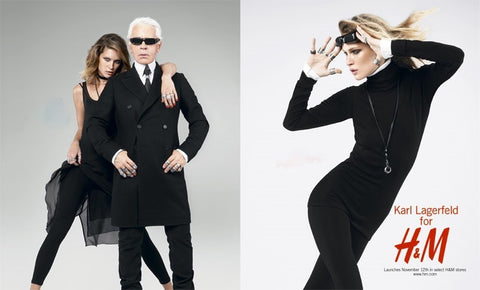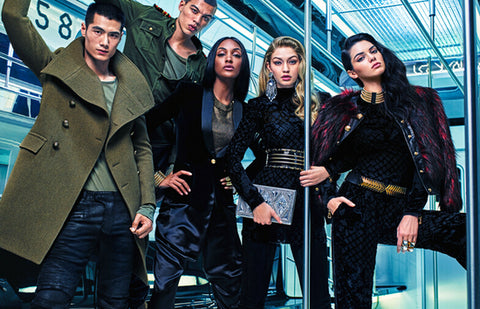By Shirley Chen
Since the incredible success of the collaboration between Karl Lagerfeld and H&M in 2004, there has been a growing number of high fashion brands collaborating with fast fashion retailers. Ranging from designer brands such as Stella McCartney, Roberto Cavalli, Comme des Garçons, Versace, and Maison Martin Margiela to style icons such as Madonna, David Beckham, Beyoncé, and Anna Dello Russo, none of these collaborations have failed. In actuality, the high probability of success made it an appealingly lucrative opportunity for luxury designers to ally with the fast fashion retailers.

(Source: http://styleblazer.com/88049/hm-collabos-which-high-low-end-collab-was-your-favorite/)
To further understand the market, we should look into the real commercial value of these collaborations. Wouldn’t a dilution of brand value occur and thus hurt the original high-end luxury market? Here are several personal opinions:
- Brand Generalization: An One-off Game
Collaborating with fast fashion retailers would surely help luxury brand explore a larger untapped market through lowering the price to a more amicable level. For instance, a dress from a designer brand can cost more than $6,000 while a dress from Balmain X H&M collaboration only costs up to $500. Imagine that if you are a super fan of high fashion but only had an average disposable income, which one would you prefer to purchase? The answer is pretty self-evident. In this sense, collaborative designs not only make high fashion more affordable but also ensure the quality and the freshness of designs, sounding like a perfect win-win solution.

However, designers are not blind to the finances of their company. By lowering their ‘attitude’ (value proposition) down from an inaccessible and elegant position, their brand image is also exposed to the risk of being diluted. What if the fast fashion retailer failed to inspect the consistency of quality and in turn hurt the original luxurious image? What if a scandal about the collaborative partnership was dropped and passed onto the luxury brand? Plus, such partnership switches the luxury brand from earning lucrative margins in the high-end niche market to the tight margin market where fast fashion retailers are currently competing in. This collaboration has usually been launched as a one-off or at most, once a year event. Sometimes, products could be designated with ‘Limited Edition’ labels and allowed to run out of stock on the release date. Despite customers having to stay on a disappointedly long waiting list to get such a ‘great deal’, no guarantee would be made towards the purchase. As such, a collection value would be added to product’s original transaction value considering its scarcity. From the perspective of economists, this results in what has been referred to as ‘Hunger Marketing’.
Something interesting that occurred was that most people who wanted the limited edition collaboration products would ultimately get one. It was only a matter of sooner or later and whether the collaborative product was from the primary or secondary market. As long as both consumers and merchants received what they wanted, few consumers really questioned the actual production volume.
- Media Attention: Commercial Speculation + Data Mining
In the era of Big Data, merchants can create value through data mining in addition to the general commercial speculation. By analyzing social media posts, the brands will be able to explore the market deeper. For example, designers can find out the demographic who contributed the most posts during the campaign and design marketing campaigns that will ensure completed purchases. They are also able to learn the real needs of the potential target market, thus better-tailoring designs to meet consumer needs.

(Source: http://www.paladinoandco.com/data-mining-for-sustainability-physical-building-components-and-beyond/#.V6M1fbh942w)
According to Crimson Hexagon’s stats, the overall number of posts referring to ‘H&M X Balmain’ reached 553,130 on Twitter and Facebook ALONE![1] Not to mention the collective media attention received from all other social media channels. Of all posts, most of social buzz was created by the celebrities such as Kendall Jenner, Gigi Hadid and Jourdan Dunn. It seemed like this was not only a collaboration between clothing brand but also a tactic that celebrities could take the advantage of!
- Astonishing Benefit: A Good Way to Kill Counterfeits?
As mentioned above, an approachable price is the most distinctive characteristic of collaborations whereas it is hard to imagine that it can be a good way to kill counterfeits as well. Being a reputable brand, quality of clothing has already been assured while additional perks such as free exchange and return policy makes the purchase even more appealing. Now with a lower price point, the only competitive advantage for counterfeits – cheaper price, is undoubtedly lackluster if not eliminated. Counterfeits will then have to further lower their price to remain competitive, ultimately causing the counterfeit market to face extremely tinny margins and become unsustainable. However, a key factor in ensuring the success of this strategy is that consumers stay fastidious and will be able to distinguish the difference between counterfeits and authentic products. Thus it is essential that even through collaborations, the quality and design of products must not be forgotten.
- Trial-run of Potential Product Line?
Last but not least, some merchants has found it as a practical way to test the new market. In 2010, Stella McCartney launched its childrenswear product line after a tie-in partnership with Gap while last week Alexander Wang announced their collaboration with Adidas building on previous success of their sportswear collection with H&M.

(Source: http://www.stylenest.co.uk/competitions/win-250-worth-of-stella-mccartney-kids-clothes/)
The lower price point does at time hurt the brand image by diluting brand equity, but it does present the possibility to make the brand more accessible to the younger generation. Thus an earlier introduction could in the long-term build brand loyalty. By reaching the youths earlier and building trust through a positive relationship of quality and experience, a positive reinforcement will be created and allow luxury brand to introduce higher priced higher margin products as the disposable income of these loyal markets continues to grow.
As the number of amazing chemistries created by the collaboration between luxury brands and fast fashion retailers continues to grow, fashion followers are looking forward to more fresh partnerships happening in the market. Now, a question remains: can such collaborations continue to create value as the market floods with an increasing number of partnerships? We shall see!
[1] http://www.crimsonhexagon.com/blog/current-events/balmain-x-hm-the-impact-of-influencer-marketing/